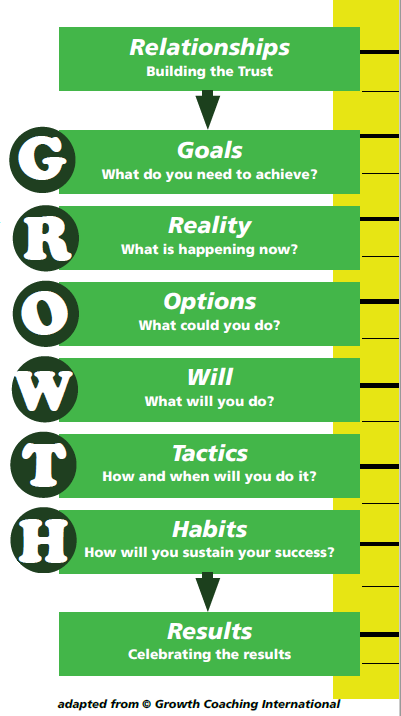GROWTH Coaching: Making Time for Reflection and Action Planning Even in Turbulent Times

by Hillary Major
As a professional development specialist, I’ve long believed in the value of coaching, both as coach and coachee. Over the years, the emphasis on evidence-based best practices in professional learning—approaches that are intensive, ongoing, and job-embedded; are specific and focused; build knowledge and relationships through collaborative learning; are differentiated to address practitioners’ needs; and incorporate clear feedback and outcome data—have only highlighted the importance of coaching as tool for professional growth. Our recent period of enforced telework gave several of us at VALRC a chance to deepen our coaching know-how by taking virtual coaching courses offered by the Instructional Coaching Group, a consulting group led by education researcher and coaching expert Jim Knight.
The course I took, “A Process for Distance Coaching,” centered around the GROWTH model for coaching. GROWTH was developed as a tool for leaders, and it is adaptable to address a variety of problems or purposes. It can be used to focus on issues that speak primarily to leaders and administrators (How can we increase access to technology for the adult learners in our community? How should we respond to this RFP? How can we improve learner recruitment? Reduce staff and volunteer turnover?) as well as those that are likely to be on classroom teachers’ minds (How do I increase student interaction in an online learning environment? How can I adapt my teaching and curriculum for remote learning? How can I increase differentiation in my multilevel class? How can I get students to do more writing? How can I help students improve their quantitative reasoning?). GROWTH makes use of facilitative coaching: the coach should approach the conversation as a partner, but instead of providing suggestions, the coach listens deeply and offers guiding questions. GROWTH is grounded in faith that people know how to solve their own problems (even when the process requires additional learning or connecting with partners, funders, colleagues, or experts) but that most people benefit from support in considering their options and putting together an action plan.
The six elements of the GROWTH model are:
- Goal: The coach helps the coachee set a SMART goal. A coachee may come with a problem or purpose in mind, and the coach’s questions can help clarify the goal and ensure it is specific, measurable, and achievable. The goal becomes the guiding focus for the coaching conversation.
- Reality: The coach talks the coachee through their current situation, acknowledging resources, barriers, and other factors that will impact the coachee as they work toward their goal.
- Options: In this brainstorming step, the coach’s questions should encourage the coachee to consider their “first instinct” solutions as well as give them space to consider other alternatives.
- Will: Here the coachee commits to the action steps they will take to meet their goal.
- Tactics: Here, with help from the coach’s prompting, the coachee fills in the “how” and “when,” making their next steps concrete.
- Habits: This step focuses on sustaining progress. The coachee is encouraged to reflect on habits and personal qualities that may help or hinder them in their progress and to consider those tendencies in their action plan.

The GROWTH model provides questions to guide the coach at each step of the process, but these are not a script. It’s important that the coach be flexible in adapting the model to their own practice and the actual coaching situation. While a GROWTH coach may not be an expert in the coachee’s discipline, they should bring their coaching skills to the conversation, listening actively, empathizing, clarifying, and asking cogent questions. The developers of GROWTH also emphasize a “coaching way of being” that includes humility, positivity, and a solution focus. Additionally, there are two important “Rs” that bookend the GROWTH process: relationship and results. A relationship grounded in trust and transparency sets the stage for success, and after the initial planning conversation, there should be opportunities to follow up on—and celebrate—results.
The six GROWTH elements may seem like a lot to get through in a single conversation, but in fact, a GROWTH coaching session can often address them all productively in about a half hour. A coachee may find that just a few sessions provide valuable “space to think” through an important challenge as well as motivation in carrying out their action plan. The timeframe for individual conversations as well as the number of meetings will vary based on the goal selected and can be adjusted by each coach/coachee pair. This flexibility makes the GROWTH model particularly relevant in times of change and transition. GROWTH has been studied primarily with education leaders and in teacher-student conversations, but it can also be applied in student-to-student interactions and in community contexts.
Do you think you would benefit from a dedicated time to think through your approach to an upcoming project or current challenge? Would a supportive listener with a fresh perspective and a solution focus help you? Would any of the application ideas below be a good fit for your program or situation? Can you think of other ways the GROWTH model might be relevant in your classroom, program, or community?
- If you have a formal or informal mentoring relationship with another educator, try including GROWTH in a few of your conversations. It may help bring energy and focus to your discussions.
- Pair up teacher-to-teacher or manager- to-manager. Find an interested peer and agree to be GROWTH partners. Take turns as coach and coachee. Commit to at least two half-hour conversations in each role.
- If you are an instructional technology specialist, curriculum specialist, or other teacher leader, try using the GROWTH approach in your conversations with teachers.
- Use GROWTH in one-on-one goal-setting conversations with learners. Use GROWTH with students during the intake process when you help them strategize about how they will overcome barriers to their educational goals.
- Encourage students to pair up and use the GROWTH model to support each other. They will be practicing communication skills and workforce preparation skills such as critical thinking, self management, and working with others. (Be sure students are willing: coaching should always be opt-in rather than mandatory. Explicitly address coaching priorities including respect and confidentiality.)
- Explore whether the GROWTH model can play a role in career counseling, case management, or other aspects of your workforce development partnerships.
Learn more:
- A brief overview of the GROWTH model and other resources from GROWTH Coaching International
- Radical Learners blog and other resources from Jim Knight and ICG

Hillary Major is the Instructional Standards and Communications Specialist at the Virginia Adult Learning Resource Center. She works to assist Virginia adult educators as they incorporate the College and Career Readiness Standards for Adult Education into their programs and instruction. She is a coordinator for Virginia’s Teaching Skills that Matter pilot team.
1See the LINCS Professional Development (PD) Center Self-Assessment Tool.
2Note that these questions focus mostly on instructor behaviors rather than student outcomes. Measurable GROWTH goals for instructors can focus on teacher or student outcomes. This is a difference between GROWTH coaching and Impact Cycle instructional coaching, the approach Jim Knight is most known for. Impact cycle coaching also tends to be more intensive/of longer duration and uses a dialogical rather than facilitative coaching approach.
3You may find that some of your workforce development system partners are using Motivational Interviewing, a facilitative counseling method that has some similarities to the GROWTH approach.